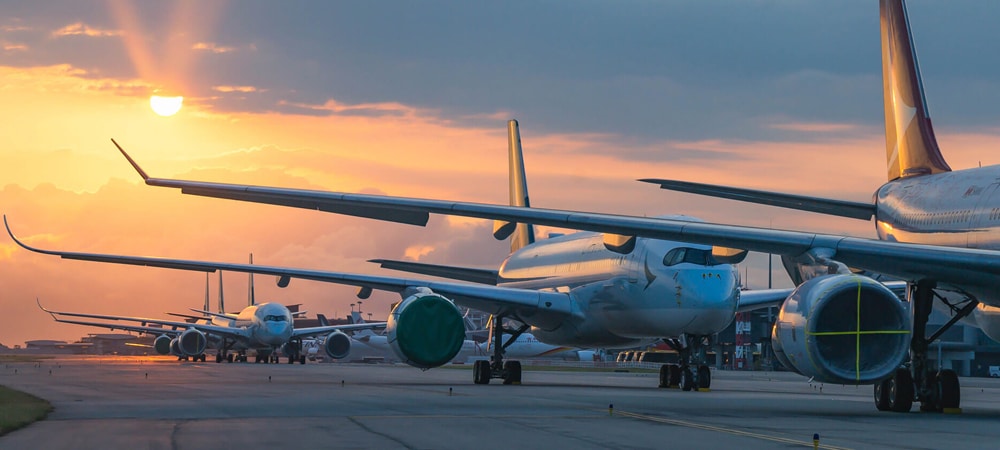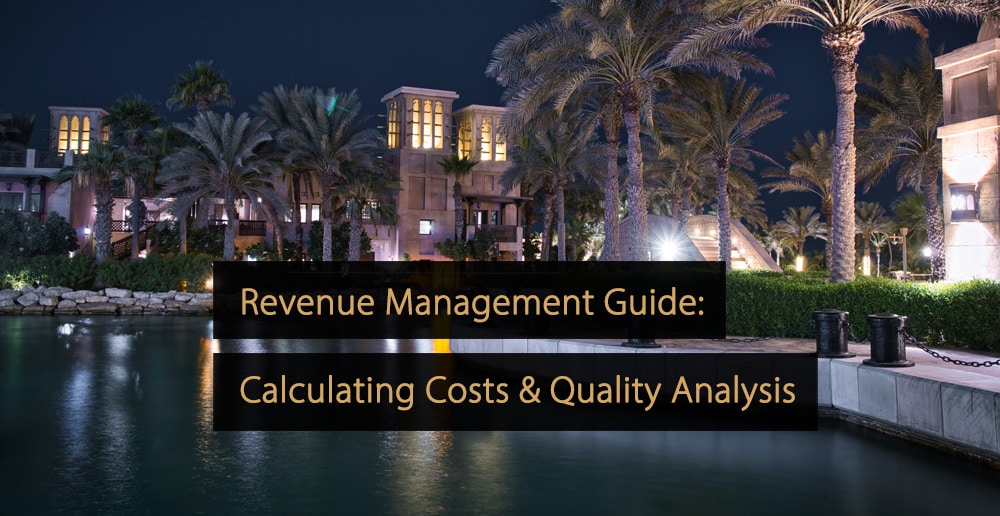Given the volatility of demand and the high fixed costs involved in operating commercial flights, it’s no surprise that the airline industry has always been at the forefront of revenue management. Commercial airlines were some of the first companies to analyze consumer behavior and tailor their prices to the information. In this article, you’ll learn everything you need to know about revenue management.
Table of Contents:
- What Is the Airline Industry?
- What Is Revenue Management?
- Historical Overview of Airline Revenue Management
- Revenue Management System (RMS)
- Airline Revenue Management Strategy Components & Examples
- Global Distribution Channels & OTAs in Airline Revenue Management
- Challenges in Airline Revenue Management
- Revenue and Yield Management
- Revenue Management Consulting
What Is the Airline Industry?
Before discussing airline revenue management, examining the airline industry is useful. Essentially, an airline is any company whose primary purpose is to transport people or cargo by air. Airlines range from major companies operating hundreds of planes worldwide, to small companies with a handful of planes serving just one or two airports.
An airline can focus on operating regular flights at scheduled times or offer chartered services. Some companies offer both. These companies make up the airline industry. The airline industry is distinct from the aviation industry. The airline industry deals with commercial travel and distribution services to paying customers.
The aviation industry is more broad, covering all forms of industry related to powered flight. This would include airlines, aerospace research organizations, aircraft manufacturers, flight instructors, regulatory bodies, etc. To learn more about the aviation industry, read “Airline Industry: All You Need to Know About The Airline Sector.”
Image attribution: SATAIR
What Is Revenue Management?
Revenue management is a set of concepts and practices directed toward optimizing an enterprise’s financial results. In the broadest terms, revenue management uses analytics to predict future customer behavior. This lets businesses fine-tune the availability of their products and services to generate the maximum amount of revenue with the minimum amount of outlay.
Revenue management is especially important for businesses where consumer demand can fluctuate, and failing to accurately predict demand will result in a significant loss of revenue. Airline revenue management was the earliest form of revenue management, but it’s crucial to other industries, too.
Examples include food and beverage-related services, hotels, and tour operators. While good revenue management can benefit any business, it’s vital for airlines. To learn more about revenue management and total revenue management (TRM), read “Revenue Management; clearly explained!“
Historical Overview of Airline Revenue Management
The airline industry was the originator of the revenue management concept. Early commercial airlines followed a simple fixed-price model. This had significant drawbacks for businesses with high fixed costs and fluctuating demand.
With the introduction of computer technology in the ’70s and especially the ’80s, it became possible for aviation management to create more flexible and adaptive pricing strategies. Airlines were better able to analyze demand patterns and tailor their services and price structure accordingly. As technology has advanced and the amount of available data has grown, airline revenue management has become increasingly sophisticated.
Revenue Management System (RMS)
Revenue management is the only way to maintain a viable business for anyone operating within an industry that faces steep running costs and dynamic consumer demand, from an airline to a hotel. You need to adopt an effective revenue management system (RMS) to succeed. These software solutions help turn consumer behavior data into meaningful and actionable predictions about future demand.
A revenue management system can take key performance data, revenue estimations, and competitor information, and use this to create the optimal pricing structure for your business. Sophisticated RMS solutions can apply these analytics and pricing tactics across all aspects of your business, boosting your revenue and increasing efficiency.
RMS is the key to a dynamic and effective pricing structure that responds to fluctuating demand in real time. To discover more about RMS technology, the kinds of solutions available, and how they can help your business to succeed, read “Revenue Management System (RMS): What Are the Advantages?“ today.
Airline Revenue Management Strategy Components & Examples
In this section, we’ll look at some airline industry revenue management examples.
Dynamic Pricing
Dynamic pricing allows airline companies to adapt pricing rapidly to reflect shifts in consumer demand and other factors. It’s a vital component of airline revenue management and was one of the foundational elements from the earliest days of this approach.
Dynamic pricing means an airline can change its prices quickly and responsively when something changes. Factors that might affect ticket pricing include changes in flight frequency, capacity adjustments, the day of the week, the time, the season, and current or future weather. Competitors’ routes and pricing can also be factored in.
If demand for a flight is high, for instance, ticket prices can be raised for the remaining seats. If it’s low, the airline can reduce prices to sell more seats and increase revenue. Dynamic pricing allows airlines to sell the maximum number of seats at an optimal price, something that’s hugely important in the competitive airline industry.
Video: Dynamic pricing in airline industry: why flight fares constantly change
Passenger Profiling
Passenger profiling is the practice of grouping passengers into different categories and applying pricing to each category. As an example, leisure travelers generally book well in advance of their flights, often several months ahead of travel, meaning that when flights are released, the airline will raise the ticket prices to capitalize on this higher demand from leisure travelers.
By contrast, business travelers may need to book flights at short notice and are less sensitive to high-priced fares. Where a route is popular with business travelers, prices will be set low to fill flights rapidly. They can then be raised as the travel date gets closer.
Demand Forecasting
Airlines have used historical data and information on particular routes to set ticket prices. This information is incomplete and is limited because details on specific routes are lacking. Nowadays, sophisticated data analysis tools can create more accurate forecasts for any given route, considering a range of external factors.
While traditional factors such as the day of the week, the weather, holiday dates, and political situations are still considered when making adjustments, more complex data can be used to set optimal prices. For instance, sporting or other events might increase demand for a flight.
AI & Machine Learning
Machine learning (ML) has become increasingly important to the airline industry, especially for airline revenue management. Using ML tools, airlines can go beyond forecasting based on events and better understand how these events will impact demand.
Using AI algorithms, airlines can create predictions around the impact of an event and incorporate this new data in their forecasting. Most airlines use these tools primarily to predict demand for seats on a flight. Still, some airlines are also testing the use of AI tools to predict demand for ancillary services: priority boarding, additional baggage requirements, and even food preferences.
Yield Management
Yield management is focused on optimizing revenue through strategic pricing and allocating the airline’s inventory. Yield management is one of the core components of airline revenue management and involves segmenting customers based on various factors. These can include customer behavior, demand levels, and even the time of booking.
Prices are adjusted dynamically across a range of fare classes, ensuring that the maximum of seats are filled and that each passenger is charged the optimal price for their particular requirements. Yield management helps airlines to avoid revenue loss and capture higher fares when demand is increased.
Global Distribution Channels & OTAs in Airline Revenue Management
In this section, you’ll learn about the role of global distribution channels and online travel agencies (OTAs) in airline revenue management. Offering direct booking via the airline’s website gives the airline several advantages: control over the customer experience, their data, and ticket pricing are some of these.
The downside is that you need to get customers to come to the website, which requires a significant outlay of resources on marketing. As in the hospitality industry, OTAs and traditional travel agencies can help airlines reach a vast customer base; however, these charge a high commission on flights booked through their platforms, negatively impacting the airline’s revenue. Global distribution systems (GDS), help airlines to reach more customers by connecting them with travel agents.
This increases the airline’s reach but incurs additional distribution costs. Airlines use data from different marketing channels as part of their revenue management strategy, helping optimize ticket prices and revenue allocation. The situation for airlines is complex, as they must balance revenue maximization with their market presence.
Challenges in Airline Revenue Management
There are significant challenges that airlines must navigate when deploying revenue management strategies. Here are some of the most critical issues.
Seasonality
Seasonality is a significant issue for the travel industry and greatly affects airline revenue management. Factors such as weather, school holidays, and trends in tourism all impact flight demand. When demand is high, airlines need to work within capacity constraints. It’s important to ensure availability remains adequate without overbooking or incurring revenue loss. During off-peak periods, demand is lower, and resources may be underutilized, affecting profitability.
Capacity must be matched to demand, a complex issue requiring accurate forecasting, flexible scheduling, and effective yield management. There are also operational challenges relating to seasonal destinations: airport infrastructure, may be limited, and workforce planning can be fraught.
Sustainability Concerns
Like many aspects of the tourism industry, air travel faces increasing scrutiny due to its high carbon emissions. Airlines must respond to concerns over this environmental impact, balancing profitability against sustainability. More sustainable aviation fuels are available but at a higher price than conventional fuel, with technical challenges further impeding the adoption of greener alternatives.
Air travel is in a period of rapid growth, making it difficult to offset emissions. Airline revenue management must factor in regulations, its public image, and increasing customer demands for more ecologically friendly travel; airline jobs now include roles like “sustainability consultant.” A collaborative approach involving airlines, industry stakeholders, and governments is needed.
Competitive Industry
The rivalry between airlines competing for a market share has grown more fierce in recent years. Customers are increasingly price-sensitive, and airlines are limited as to the differentiation they can offer, since their core services are essentially the same. Customers can easily compare flights and accommodation online, further impacting loyalty.
Airlines must balance operational efficiency with offering attractive fares and services. The rise of low-cost budget carriers and severe fluctuations in the price of fuel present additional challenges. Airline revenue management is increasingly important for maintaining a solid market position.
Revenue and Yield Management
Revenue management and yield management are increasingly vital to many industries. Revenue management has a broad focus, covering the costs and benefits associated with all aspects of a business and how to maximize profit. Yield management takes a more narrow view, focusing specifically on extracting the maximum profit possible from a company’s inventory.
If this article on airline revenue management has piqued your interest, you’ll want to read “Revenue Management versus Yield Management.“ This in-depth article explains revenue management and yield management in detail: what they are, how they differ, and why they’re important for your business.
Revenue Management Consulting
If the thought of implementing revenue management makes your head spin, you’re not alone. Adopting revenue management strategies can be a complex undertaking, and it’s increasingly common for businesses to call in expert help. Enter the revenue management consultant whose expertise and outside perspective can help your business to thrive.
Hiring a consultant takes the pressure off your staff and avoids the costs of recruiting an in-house specialist. In “Revenue Management Consulting; Benefits of Hiring a Consultant,“ you’ll learn about the role of the consultant in revenue management and how hiring one can help your business.
Airline Revenue Management FAQs
Airline revenue management involves strategies like dynamic pricing to ensure revenue isn’t lost through unused seats or sub-optimal pricing. It is highly complex, involving various factors, and is crucial for modern airline companies.
More Tips to Grow Your Business
Revfine.com is the leading knowledge platform for the hospitality and travel industry. Professionals use our insights, strategies, and actionable tips to get inspired, optimize revenue, innovate processes, and improve customer experience.Explore expert advice on management, marketing, revenue management, operations, software, and technology in our dedicated Hotel, Hospitality, and Travel & Tourism categories.
This article is written by:
Hi, I am Martijn Barten, founder of Revfine.com. With 20 years of experience in the hospitality industry, I specialize in optimizing revenue by combining revenue management with marketing strategies. I have successfully developed, implemented, and managed revenue management and marketing strategies for individual properties and multi-property portfolios.










Leave A Comment